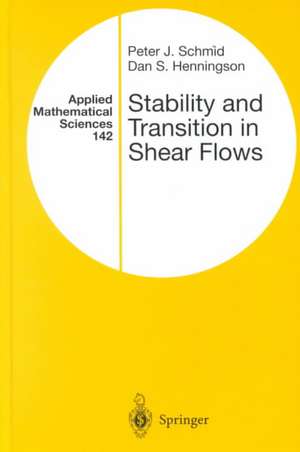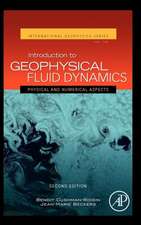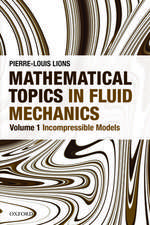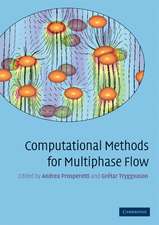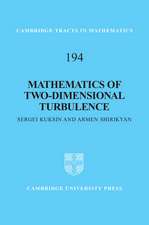Stability and Transition in Shear Flows: Applied Mathematical Sciences, cartea 142
Autor Peter J. Schmid, Dan S. Henningsonen Limba Engleză Hardback – 28 dec 2000
| Toate formatele și edițiile | Preț | Express |
|---|---|---|
| Paperback (1) | 1393.27 lei 6-8 săpt. | |
| Springer – 16 sep 2012 | 1393.27 lei 6-8 săpt. | |
| Hardback (1) | 1728.55 lei 3-5 săpt. | +38.88 lei 10-14 zile |
| Springer – 28 dec 2000 | 1728.55 lei 3-5 săpt. | +38.88 lei 10-14 zile |
Din seria Applied Mathematical Sciences
- 13%
 Preț: 426.94 lei
Preț: 426.94 lei - 13%
 Preț: 426.46 lei
Preț: 426.46 lei - 13%
 Preț: 427.63 lei
Preț: 427.63 lei - 24%
 Preț: 906.78 lei
Preț: 906.78 lei - 23%
 Preț: 659.05 lei
Preț: 659.05 lei -
 Preț: 375.64 lei
Preț: 375.64 lei - 18%
 Preț: 909.47 lei
Preț: 909.47 lei - 18%
 Preț: 795.02 lei
Preț: 795.02 lei - 18%
 Preț: 950.52 lei
Preț: 950.52 lei - 15%
 Preț: 645.47 lei
Preț: 645.47 lei - 20%
 Preț: 755.46 lei
Preț: 755.46 lei -
 Preț: 382.65 lei
Preț: 382.65 lei - 24%
 Preț: 808.03 lei
Preț: 808.03 lei -
 Preț: 452.62 lei
Preț: 452.62 lei -
 Preț: 190.23 lei
Preț: 190.23 lei -
 Preț: 399.12 lei
Preț: 399.12 lei - 18%
 Preț: 966.90 lei
Preț: 966.90 lei - 15%
 Preț: 643.48 lei
Preț: 643.48 lei - 15%
 Preț: 528.80 lei
Preț: 528.80 lei -
 Preț: 413.15 lei
Preț: 413.15 lei -
 Preț: 390.25 lei
Preț: 390.25 lei - 18%
 Preț: 736.01 lei
Preț: 736.01 lei - 18%
 Preț: 1411.05 lei
Preț: 1411.05 lei - 15%
 Preț: 711.21 lei
Preț: 711.21 lei -
 Preț: 395.47 lei
Preț: 395.47 lei - 18%
 Preț: 1017.26 lei
Preț: 1017.26 lei -
 Preț: 403.15 lei
Preț: 403.15 lei - 18%
 Preț: 1130.14 lei
Preț: 1130.14 lei - 18%
 Preț: 1134.87 lei
Preț: 1134.87 lei - 18%
 Preț: 1329.00 lei
Preț: 1329.00 lei - 18%
 Preț: 1129.65 lei
Preț: 1129.65 lei - 18%
 Preț: 1140.71 lei
Preț: 1140.71 lei
Preț: 1728.55 lei
Preț vechi: 1899.51 lei
-9% Nou
Puncte Express: 2593
Preț estimativ în valută:
330.75€ • 346.26$ • 273.68£
330.75€ • 346.26$ • 273.68£
Carte disponibilă
Livrare economică 15-29 martie
Livrare express 04-08 martie pentru 48.87 lei
Preluare comenzi: 021 569.72.76
Specificații
ISBN-13: 9780387989853
ISBN-10: 0387989854
Pagini: 576
Ilustrații: XIII, 558 p.
Dimensiuni: 155 x 235 x 36 mm
Greutate: 0.98 kg
Ediția:2001
Editura: Springer
Colecția Springer
Seria Applied Mathematical Sciences
Locul publicării:New York, NY, United States
ISBN-10: 0387989854
Pagini: 576
Ilustrații: XIII, 558 p.
Dimensiuni: 155 x 235 x 36 mm
Greutate: 0.98 kg
Ediția:2001
Editura: Springer
Colecția Springer
Seria Applied Mathematical Sciences
Locul publicării:New York, NY, United States
Public țintă
ResearchCuprins
1 Introduction and General Results.- 1.1 Introduction.- 1.2 Nonlinear Disturbance Equations.- 1.3 Definition of Stability and Critical Reynolds Numbers.- 1.4 The Reynolds-Orr Equation.- I Temporal Stability of Parallel Shear Flows.- 2 Linear Inviscid Analysis.- 3 Eigensolutions to the Viscous Problem.- 4 The Viscous Initial Value Problem.- 5 Nonlinear Stability.- II Stability of Complex Flows and Transition.- 6 Temporal Stability of Complex Flows.- 7 Growth of Disturbances in Space.- 8 Secondary Instability.- 9 Transition to Turbulence.- III Appendix.- A Numerical Issues and Computer Programs.- A.1 Global versus Local Methods.- A.2 Runge-Kutta Methods.- A.3 Chebyshev Expansions.- A.4 Infinite Domain and Continuous Spectrum.- A.5 Chebyshev Discretization of the Orr-Sommerfeld Equation.- A.6 MATLAB Codes for Hydrodynamic Stability Calculations.- A.7 Eigenvalues of Parallel Shear Flows.- B Resonances and Degeneracies.- B.1 Resonances and Degeneracies.- B.2 Orr-Sommerfeld-Squire Resonance.- C Adjoint of the Linearized Boundary Layer Equation.- C.1 Adjoint of the Linearized Boundary Layer Equation.- D Selected Problems on Part I.
Recenzii
From the reviews:
SIAM REVIEW
"This book presents a modern treatment of stability in shear flows. Stability theory has seen a number of classic treatments over the years…Schmid and Henningson’s book builds on these and offers much new material relevant to stability in shear flows…The MATLAB codes included in the appendix and a discussion of the effects of rounding error and resolution on the computations of eigenvalues of linear stability operators will be particularly helpful for students and researchers as they get started with stability computations…As the basis for a course, the first part of the book would permit students to build a solid foundation in classical and modern stability theory, while a selection of advanced topics from the second half of the book could be treated later in the course or through projects and independent study by students."
ZENTRALBLATT MATH
"The book addresses to graduate students as well as to a broad community of researchers with a basic knowledge of fundamental fluid dynamics…The topics are treated with mathematical rigor while the physical motivation and usefulness of mathematical concepts is kept close at hand. The work is elegantly structured, and the graphical material is very suggestive."
SIAM REVIEW
"This book presents a modern treatment of stability in shear flows. Stability theory has seen a number of classic treatments over the years…Schmid and Henningson’s book builds on these and offers much new material relevant to stability in shear flows…The MATLAB codes included in the appendix and a discussion of the effects of rounding error and resolution on the computations of eigenvalues of linear stability operators will be particularly helpful for students and researchers as they get started with stability computations…As the basis for a course, the first part of the book would permit students to build a solid foundation in classical and modern stability theory, while a selection of advanced topics from the second half of the book could be treated later in the course or through projects and independent study by students."
ZENTRALBLATT MATH
"The book addresses to graduate students as well as to a broad community of researchers with a basic knowledge of fundamental fluid dynamics…The topics are treated with mathematical rigor while the physical motivation and usefulness of mathematical concepts is kept close at hand. The work is elegantly structured, and the graphical material is very suggestive."
